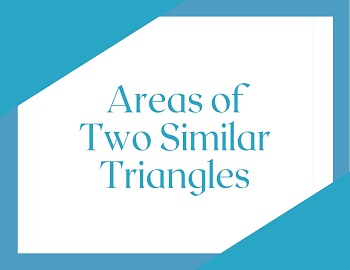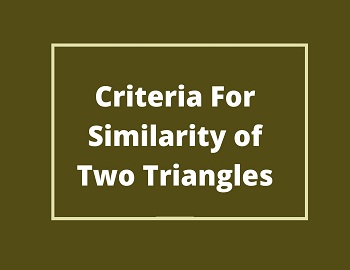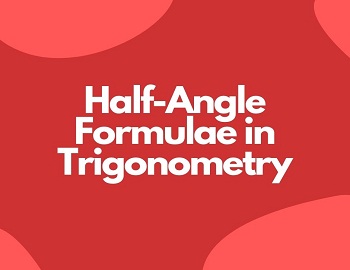Geometric Mean:
If a and b be the two numbers and G1, G2, G3, ………. Gn is the ‘n’ numbers between a and b such that a, G1, G2, G3, ………. Gn, b are in Geometric Progression then G1, G2, G3, ………. Gn is called the Geometric means between a and b.
Single Geometric Mean Between a and b:
The Geometric Mean between a and b is √(ab).
Insertion of n Geometric Mean between a and b:
Let G1, G2, G3, ………. Gn be the n geometric means between a and b.
∴ a, G1, G2, G3, ………. Gn, b are in geometric progression.
Let ‘r’ be the common ratio of geometric progression.
| Now, b = an+2 ⇒ b = arn+2-1 ⇒ b = arn+1 ⇒ b/a = rn+1 ⇒ r = (b/a)1/n+1 ∴ G1 = ar G2 = ar2 G3 = ar3 ………….. Gn = arn |
Relation Between Arithmetic Mean and Geometric Mean:
| Let a and b be the two numbers, then A = (a + b)/2 and G = √(ab) Now, A – G = [(a + b)/2] – [√(ab)] ⇒ A – G = [(a + b – 2 √a √b)]/2 ⇒ A – G = [(√a)2 + (√b)2 – 2 √a √b]/2 ⇒ A – G = (√a – √b)2/2 A – G > 0 ⇒ A > G i.e. Arithmetic Mean > Geometric Mean |
If A and G be the Arithmetic Mean and Geometric Mean between two numbers then they satisfy the equation having a and b as its roots given-
| x2 – 2Ax + G2 = 0 |
If A and G be the Arithmetic Mean and Geometric Mean between two numbers then the numbers are-
| A ± √(A2 – G2) |
| Example- Find the value of n so that (an+1 + bn+1)/(an + bn) is the geometric mean between a and b. Solution- Geometric Mean between a and b = √(ab) Also for some values of n, the geometric mean between a and b is [(an+1 + bn+1)/(an + bn)] ⇒ (an+1 + bn+1)/(an + bn) = √(ab) ⇒ (an+1 + bn+1)/(an + bn) = a1/2b1/2 ⇒ an+1 + bn+1 = an+1/2 b1/2 + bn+1/2 a1/2 ⇒ an+1 – an+1/2 b1/2 = bn+1/2 a1/2 – bn+1 ⇒ an+1/2 (a1/2 – b1/2) = bn+1/2 (a1/2 – b1/2) ⇒ an+1/2 = bn+1/2 ⇒ an+1/2/bn+1/2 = 1 ⇒ (a/b)n+1/2 = (a/b)0 ⇒ n + 1/2 = 0 ⇒ n = -1/2 |
| Example- Insert 3 geometric means between 1/9 and 9. Solution- Let G1, G2, G3 be the 3 geometric means between 1/9 and 9. ∴ 1/9, G1, G2, G3, 9 are in geometric progression. Let r be the common ratio of geometric progression. Now, r = (b/a)1/n+1 ⇒ r = [9/(1/9)]1/(3+1) ⇒ r = (81)1/4 ⇒ r = (34)1/4 ⇒ r = 3 ∴ 3 geometric means are (1/9) 3, (1/9) 32, (1/9) 33 = 1/3, 1, 3 |
| Example- The A.M. between two numbers is 34 and their G.M. is 16. Find the numbers. Solution- Here, A = 34, G = 16 ∴ Numbers are A ± √(A2 – G2) = 34 ± √(342 – 162) = 34 ± √[(34 -16) (34 + 16)] = 34 ± √(18 x 50) = 34 ± √(9 x 2 x 10) = 34 ± 3 x 10 = 34 ± 30 ∴ Numbers are 64 and 4 |
| Example- If the A.M. of two numbers a and b (a > b) is twice as their G.M. then prove that a : b = (2 + √3) : (2 – √3). Solution- A = (a + b)/2 ……….(i) and G = √(ab) ……….(ii) Also A = 2a ⇒ (a + b)/2 = 2 √(ab) ⇒ a + b = 4√(ab) ……….(iii) Now, (a – b)2 = (a + b)2 – 4ab ⇒ (a – b)2 = [4√(ab)]2 – 4ab [using (iii)] ⇒ (a – b)2 = 16ab – 4ab ⇒ (a – b)2 = 12ab ⇒ (a – b) = √(12ab) ⇒ (a – b) = 2√(3ab) ……….(iv) Dividing (iii) by (iv):- (a + b)/(a – b) = [4√(ab)]/[2√3√ab] ⇒ (a + b)/(a – b) = 2/√3 Apply Componendo and Dividendo:- [(a + b) + (a – b)]/[(a + b) – (a – b)] = (2 + √3)/(2 – √3) ⇒ 2a/2b = (2 + √3)/(2 – √3) ⇒ a/b = (2 + √3)/(2 – √3) |
| Example- If a, b, c are in A.P., x is the G.M. between a and b, y is the G.M. between b and c. Then prove that b2 is the A.M. between x2 and y2. Solution- a, b, c are in A.P. ⇒ 2b = a + c ……….(i) x is the G.M. between a and b. ⇒ x2 = ab ……….(ii) Also, y is the G.M. between b and c. ⇒ y2 = bc ……….(iii) Add (ii) and (iii):- x2 + y2 = ab + bc ⇒ x2 + y2 = b (a + c) ⇒ x2 + y2 = b (2b) ⇒ x2 + y2 = 2b2 ∴ b2 is the A.M. between x2 and y2. |
| Example- Find the sum of an infinite G.P. whose first term is 28 and the fourth is 4/49. Solution- Let a and r be the first term and common ratio of a G.P. respectively. Here, a = 28 and a = 4/49 ⇒ ar3 = 4/49 ⇒ 28r3 = 4/49 ⇒ r3 = 1/(49 x 7) ⇒ r3 = (1/7)3 ⇒ r = 1/7 ∴ S∞ = a/(1 – r) ⇒ S∞ = 28/(1 – 1/7) ⇒ S∞ = 28/(6/7) ⇒ S∞ = (28 x 7)/6 ⇒ S∞ = 98/3 |
| Example- The first term of a G.P. exceeds the second term by two and the sum to infinity is 9/2. Find the G.P. Solution- Let a be the first term and r be the common ratio of G.P. Now, a1 – a2 = 2 ⇒ a – ar = 2 ⇒ a (1 – r) = 2 ⇒ 1 – r = 2/a ……….(i) Also, S∞ = 9/2 ⇒ a/(1 – r) = 9/2 ⇒ a/(2/a) = 9/2 [using (i)] ⇒ a2 = 9 ⇒ a = ± 3 When a = 3, equation (i) becomes- 1 – r = 2/3 ⇒ r = 1 – 2/3 ⇒ r = 1/3 G.P. is 3, 3 x 1/3, 3 x 1/32, ………. = 3, 1, 1/3, ………. When a = -3, equation (i) becomes- 1 – r = 2/(-3) ⇒ r = 1 + 2/3 ⇒ r = 5/3 > 1 which is not possible ∴ a ≠ -3 |









Comments (No)